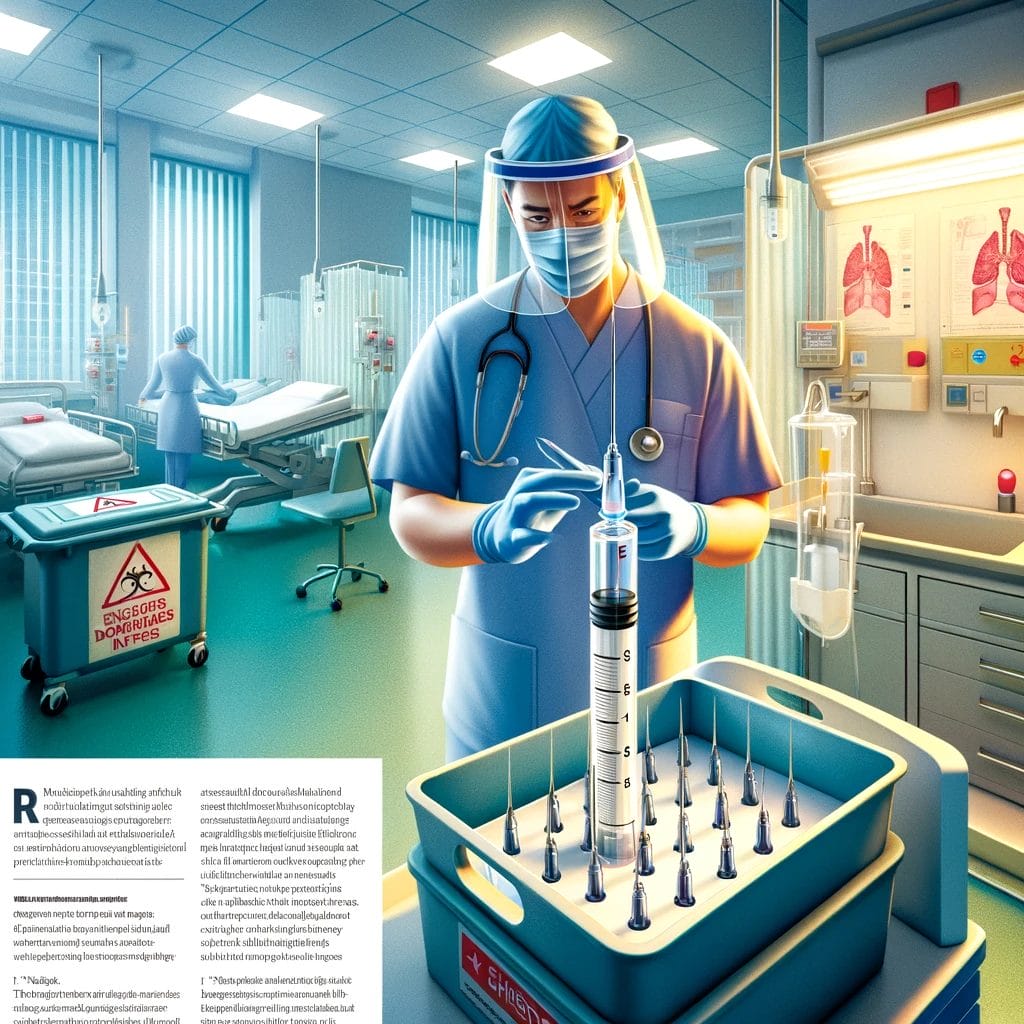In the domain of occupational health and safety within the healthcare sector, the assessment and mitigation of risks associated with bloodborne pathogens consequent to sharps injury incidents are of critical importance. The gravity of this issue is underscored by its direct implications for the wellbeing of healthcare professionals and, by extension, the public they serve. This comprehensive examination seeks to delineate the spectrum of risks posed by bloodborne pathogens through sharps injuries, with an emphasis on the Australian healthcare context. By synthesising data on the epidemiology of sharps injuries, the nature and transmission of bloodborne pathogens, risk quantification, and strategic prevention measures, this discourse aims to augment the occupational health protocols employed within healthcare settings. The ensuing analysis is structured to provide healthcare stakeholders with a profound understanding of the subject matter, thereby reinforcing the infrastructure supporting patient and practitioner safety.
Epidemiology of Sharps Injuries
Sharps injuries represent a substantial occupational hazard for healthcare workers, encompassing any injury inflicted by instruments capable of puncturing or slicing skin, such as needles, scalpel blades, and broken glass. Annually, thousands of Australian healthcare workers encounter the risk of exposure to bloodborne pathogens due to sharps injuries, particularly in environments where the manipulation of sharp instruments is frequent and integral to patient care.
Nature and Transmission of Bloodborne Pathogens
Bloodborne pathogens, including but not limited to hepatitis B virus (HBV), hepatitis C virus (HCV), and human immunodeficiency virus (HIV), constitute a significant threat to health. These pathogens can cause both acute and chronic disease states, leading to considerable morbidity and mortality. The mechanism of transmission through sharps injuries highlights the critical need for rigorous risk assessment and intervention in healthcare facilities.
Risk Assessment Methodologies
Assessing the risk of transmission of bloodborne pathogens involves a complex interplay of factors, including the prevalence of the pathogen within the patient population, the nature of the sharps injury, and the susceptibility of the healthcare worker. Risk assessment models often incorporate quantitative measures to estimate the likelihood of pathogen transmission, factoring in the depth and severity of the injury, the type of sharp instrument involved, and the known or suspected infection status of the source patient.
Quantifying the Risk of Infection
The quantification of infection risk post-exposure to bloodborne pathogens is pivotal for informing preventive strategies and post-exposure prophylaxis. The percentage risk of infection varies among different pathogens:
- Hepatitis B Virus (HBV): The risk of HBV transmission following a percutaneous exposure to HBsAg-positive blood can range from 6% to 30%, depending on the e antigen status of the source and the vaccination and immune status of the exposed individual.
- Hepatitis C Virus (HCV): The estimated risk of HCV transmission after a needlestick or sharps exposure to HCV-positive blood is approximately 1.8%.
- Human Immunodeficiency Virus (HIV): The risk of HIV transmission after a percutaneous exposure to HIV-infected blood is approximately 0.3%.
These percentages underscore the variable but significant risk posed by different bloodborne pathogens, necessitating tailored approaches to risk management and exposure response.
Implementation of Preventative Measures
The mitigation of risks associated with bloodborne pathogens in sharps injury incidents necessitates a comprehensive strategy, encompassing the adoption of safer sharps technologies, the improvement of personal protective equipment (PPE), the enactment of rigorous training programmes, and the promotion of vaccination.
Adoption of Safer Sharps Technologies
The introduction of needleless systems and sharps with engineered protective features has been demonstrated to significantly reduce the incidence of sharps injuries. These technologies are designed to minimise the handling of sharp instruments and provide a physical barrier between the healthcare worker and potential exposure to bloodborne pathogens.
Enhancement of Personal Protective Equipment (PPE)
The standardisation and augmentation of PPE use within healthcare settings serve as a critical line of defence against sharps injuries. This includes the provision of gloves, gowns, and eye protection, which are essential for reducing the risk of exposure to blood and body fluids.
Training and Education
Equipping healthcare workers with the knowledge and skills to safely handle sharps and respond effectively to injury incidents is fundamental. Training programmes should cover the correct use of PPE, the implementation of safer sharps technologies, and the procedures for post-exposure management.
Vaccination Programmes
Vaccination, particularly against HBV, is a cornerstone of preventive strategy for healthcare workers at risk of sharps injuries. Ensuring high vaccination coverage and verifying the immune status of workers are essential measures for mitigating the risk of HBV infection.
Legislative and Policy Frameworks
In Australia, the regulatory landscape governing occupational health and safety mandates comprehensive measures to prevent sharps injuries and manage the risk of bloodborne pathogen transmission. Compliance with these regulations is imperative for healthcare facilities, encompassing the implementation of risk assessment protocols, the adoption of safer practices and technologies, and the facilitation of training and vaccination programmes.
Challenges and Future Directions
Despite advancements in preventive strategies and technologies, sharps injuries remain a significant concern within healthcare settings. Ongoing challenges include the underreporting of incidents, variability in the adoption of safer technologies, and gaps in worker training and awareness. Addressing these challenges necessitates a multifaceted approach, involving policy refinement, enhanced surveillance of sharps injuries, and continuous improvement of risk assessment and management practices.
Conclusion
The assessment and mitigation of risks associated with bloodborne pathogens in the context of sharps injury incidents are imperative for safeguarding the health of healthcare workers and, by extension, the public. This comprehensive analysis has highlighted the complex nature of the risk posed by various bloodborne pathogens, the methodologies for assessing and quantifying this risk, and the multifaceted approach required to implement effective preventative measures. In the Australian healthcare milieu, adherence to legislative and regulatory frameworks, coupled with the proactive engagement of healthcare stakeholders in risk management practices, is essential. The ongoing commitment to enhancing the safety of healthcare environments through education, technological innovation, and policy development will remain critical in the endeavour to minimise the incidence of sharps injuries and the transmission of bloodborne pathogens.
If you would like to know more or would like our assistance in the areas mentioned check us out at www.intrinsicsafety.com.au. Alternately, call us on 1300 990 336 or email us at [email protected]



